Study on the Explosion Mechanism of Low-Concentration Gas and Coal Dust
Abstract
:1. Introduction
2. Experimental
2.1. Experimental Setup and Materials
2.2. Kinetic Model
3. Results and Discussion
3.1. The Flame Propagation Characteristics of Gas and Coal Dust Explosion
3.2. The Influence of Coal Particle Size on Flame Propagation Velocity
3.3. The Effect of Coal Particle Size on Flame Temperature
3.4. Mechanism of Dust and Low-Concentration Gas Explosions
4. Conclusions
- Under low concentration gas conditions, the gas–coal dust explosion flame evolves from a spherical flame to a fingertip-shaped flame, finally forming a planar flame, with the entire explosion lasting about 500 ms. The forward propagation of the flame is controlled by both gas and coal dust, with coal dust having a more significant impact.
- The flame propagation velocity during low concentration gas–coal dust explosions develop in three stages: relatively slow growth in the flame distance and velocity, followed by rapid increase, and finally a decrease in flame velocity. Smaller coal dust particles produce greater flame propagation velocity, with a steeper slope in the flame distance curve.
- At low gas concentrations, combustible gases released by coal decomposition accelerate the gas–coal dust explosion reaction. The peak temperature for Dafosi coal reaches 687 °C, higher than that of Dongtan coal (595 °C). Smaller coal dust particles with gas explosions result in higher flame temperatures.
- According to the CPD model calculations, the total predicted yields of light gases for both coals exceed 40 wt% daf. Kinetic simulations show that heat generated by gas ignition heats coal particles and surrounding gas, leading to coal decomposition and the release of light combustible gases, raising combustible gas concentrations in the system. Explosions occur when the concentration reaches the lower explosive limit.
Author Contributions
Funding
Institutional Review Board Statement
Informed Consent Statement
Data Availability Statement
Conflicts of Interest
References
- Amyotte, P.R. Solid inertants and their use in dust explosion prevention and mitigation. J. Loss Prev. Process Ind. 2006, 19, 161–173. [Google Scholar] [CrossRef]
- Han, W.; Wang, C.; Law, C.K. Role of transversal concentration gradient in detonation propagation. J. Fluid Mech. 2019, 865, 602–649. [Google Scholar] [CrossRef]
- Liu, T.; Liu, S. The impacts of coal dust on miners’ health: A review. Environ. Res. 2020, 190, 109849. [Google Scholar] [CrossRef] [PubMed]
- Tian, S.; Qin, B.; Zhang, Y.; Ma, D.; Xu, J. Experimental investigation of OH* emission spectrum characteristics and transient ignition dynamics in methane and coal dust mixtures explosions. Process Saf. Environ. Prot. 2024, 192, 669–679. [Google Scholar] [CrossRef]
- Zhao, Q.; Liu, J.; Huang, C.; Zhang, H.; Li, Y.; Chen, X.; Dai, H. Characteristics of coal dust deflagration under the atmosphere of methane and their inhibition by coal ash. Fuel 2021, 291, 120121. [Google Scholar] [CrossRef]
- Li, Q.; Lin, B.; Dai, H.; Zhao, S. Explosion characteristics of H2/CH4/air and CH4/coal dust/air mixtures. Powder Technol. 2012, 229, 222–228. [Google Scholar] [CrossRef]
- Rockwell, S.R.; Rangwala, A.S. Influence of coal dust on premixed turbulent methane–air flames. Combust. Flame 2013, 160, 635–640. [Google Scholar] [CrossRef]
- Houim, R.W.; Oran, E.S. Structure and flame speed of dilute and dense layered coal-dust explosions. J. Loss Prev. Process Ind. 2015, 36, 214–222. [Google Scholar] [CrossRef]
- Collecutt, G.; Humphreys, D.; Proud, D. CFD simulation of underground coal dust explosions and active explosion barriers. In Proceedings of the 7th International Conference on CFD in the Minerals and Process Industries, Melbourne, Australia, 9–11 December 2009; pp. 1–6. [Google Scholar]
- Li, G.; Gao, W.; Jiang, H.; Liu, J.; Zhao, F.; Jin, S.; Lu, Z. Ignition and combustion of AlH3-nanoparticles: A molecular dynamics study. Combust. Flame 2024, 269, 113667. [Google Scholar] [CrossRef]
- Kundu, S.K.; Zanganeh, J.; Eschebach, D.; Moghtaderi, B. Explosion severity of methane–coal dust hybrid mixtures in a ducted spherical vessel. Powder Technol. 2018, 323, 95–102. [Google Scholar] [CrossRef]
- Huéscar Medina, C.; Phylaktou, H.N.; Andrews, G.E.; Gibbs, B.M. Explosion characteristics of pulverised torrefied and raw Norway spruce (Picea abies) and Southern pine (Pinus palustris) in comparison to bituminous coal. Biomass Bioenergy 2015, 79, 116–127. [Google Scholar] [CrossRef]
- Jin, S.; Gao, W.; Li, G.; Geng, X.; Bi, M.; Jiang, H. Atomistic insights into p-nitrotoluene combustion via the ReaxFF molecular dynamics and density functional theory study. Process Saf. Environ. Prot. 2024, 192, 484–494. [Google Scholar] [CrossRef]
- Zhao, Q.; Zhou, L.; Wang, H.; Zhang, Y.; Li, Y.; Qiu, D.; Chen, X. Effects of methane concentration on flame propagation mechanisms and dynamic characteristics of methane/coal dust explosions. Powder Technol. 2024, 439, 119744. [Google Scholar] [CrossRef]
- Collins, P.K.; Schroeder, A.R.; Buckius, R.O.; Krier, H.; Peters, J.E. Flammability Characteristics of Treated Coals. J. Energy Resour. Technol. 1992, 114, 65–69. [Google Scholar] [CrossRef]
- Yan, Z.X.; Zhang, T.; Yan, D.Z.; Yang, H.P.; Gong, A.; Liao, Q.; Chen, Q. A Comparison Study of Hybrid Flame of Methane/Coal Dust Mixture in Vented Explosions. Adv. Mater. Res. 2014, 864–867, 801–808. [Google Scholar] [CrossRef]
- Li, Y.; Xu, H.; Wang, X. Experimental Study on the Influence of Initial Pressure on Explosion of Methane-coal Dust Mixtures. Procedia Eng. 2013, 62, 980–984. [Google Scholar] [CrossRef]
- Dong, C.; Bi, M.; Zhou, Y. Effects of obstacles and deposited coal dust on characteristics of premixed methane–air explosions in a long closed pipe. Saf. Sci. 2012, 50, 1786–1791. [Google Scholar] [CrossRef]
- Oh, K.H.; Kim, H.; Kim, J.B.; Lee, S.E. A study on the obstacle-induced variation of the gas explosion characteristics. J. Loss Prev. Process Ind. 2001, 14, 597–602. [Google Scholar] [CrossRef]
- Liu, Y.; Sun, J.; Chen, D. Flame propagation in hybrid mixture of coal dust and methane. J. Loss Prev. Process Ind. 2007, 20, 691–697. [Google Scholar] [CrossRef]
- Cashdollar, K.L. Overview of dust explosibility characteristics. J. Loss Prev. Process Ind. 2000, 13, 183–199. [Google Scholar] [CrossRef]
- Song, B.; Li, Y. Study on propagation characteristics of the secondary explosion of coal dust. Int. J. Low-Carbon Technol. 2019, 15, 89–96. [Google Scholar] [CrossRef]
- Song, B.; Li, Y. Numerical simulation on flame propagation characteristics of coal dust explosion in diagonal structure network. Chem. Eng. Trans. 2018, 66, 277–282. [Google Scholar]
- Houim, R.W.; Oran, E.S. Numerical simulation of dilute and dense layered coal-dust explosions. Proc. Combust. Inst. 2015, 35, 2083–2090. [Google Scholar] [CrossRef]
- Salamonowicz, Z.; Kotowski, M.; Półka, M.; Barnat, W. Numerical simulation of dust explosion in the spherical 20l vessel. Bull. Pol. Acad. Sci. Tech. Sci. 2015, 63, 289–293. [Google Scholar] [CrossRef]
- Semenov, I.; Utkin, P.; Markov, V. Numerical modelling of dust-layered detonation structure in a narrow tube. J. Loss Prev. Process Ind. 2013, 26, 380–386. [Google Scholar] [CrossRef]
- Shimura, K.; Matsuo, A. Using an extended CFD–DEM for the two-dimensional simulation of shock-induced layered coal-dust combustion in a narrow channel. Proc. Combust. Inst. 2019, 37, 3677–3684. [Google Scholar] [CrossRef]
- Cloney, C.T.; Ripley, R.C.; Pegg, M.J.; Amyotte, P.R. Laminar combustion regimes for hybrid mixtures of coal dust with methane gas below the gas lower flammability limit. Combust. Flame 2018, 198, 14–23. [Google Scholar] [CrossRef]
- Kim, W.; Imamura, T.; Mogi, T.; Dobashi, R. Experimental investigation on the onset of cellular instabilities and acceleration of expanding spherical flames. Int. J. Hydrogen Energy 2017, 42, 14821–14828. [Google Scholar] [CrossRef]
- Shu, T.; Xue, Y.; Liang, W.; Ren, Z. Extrapolations of laminar flame speeds from expanding spherical flames based on the finite-structure stretched flames. Combust. Flame 2021, 226, 445–454. [Google Scholar] [CrossRef]
- Krazinski, J.L.; Buckius, R.O.; Krier, H. Coal dust flames: A review and development of a model for flame propagation. Prog. Energy Combust. Sci. 1979, 5, 31–71. [Google Scholar] [CrossRef]
- Cuervo, N.; Dufaud, O.; Perrin, L. Determination of the burning velocity of gas/dust hybrid mixtures. Process Saf. Environ. Prot. 2017, 109, 704–715. [Google Scholar] [CrossRef]
- Jin, S.; Gao, W.; Huang, Z.; Bi, M.; Jiang, H.; Si, R.; Wen, G. Suppression characteristics of methane/coal dust explosions by active explosion suppression system in the large mining tunnel. Fire Saf. J. 2024, 150, 104251. [Google Scholar] [CrossRef]
- Huang, Z.; Si, R.; Wen, G.; Jin, S.; Xue, S. Experimental Study on the Isolation Effect of an Active Flame-Proof Device on a Gas Explosion in an Underground Coal Mine. Fire 2023, 6, 468. [Google Scholar] [CrossRef]
- Hosseinzadeh, S.; Vanierschot, M.; Norman, F.; Verplaetsen, F.; Berghmans, J. Flame propagation and flow field measurements in a Hartmann dust explosion tube. Powder Technol. 2018, 323, 346–356. [Google Scholar] [CrossRef]
- Andrews, G.E.; Bradley, D. Determination of burning velocities: A critical review. Combust. Flame 1972, 18, 133–153. [Google Scholar] [CrossRef]
- Cuervo, N. Influences of Turbulence and Combustion Regimes on Explosions of Gas-Dust Hydrid Mixtures. Ph.D. Thesis, Universite de Lorraine, Lorraine, France, 2015. [Google Scholar]

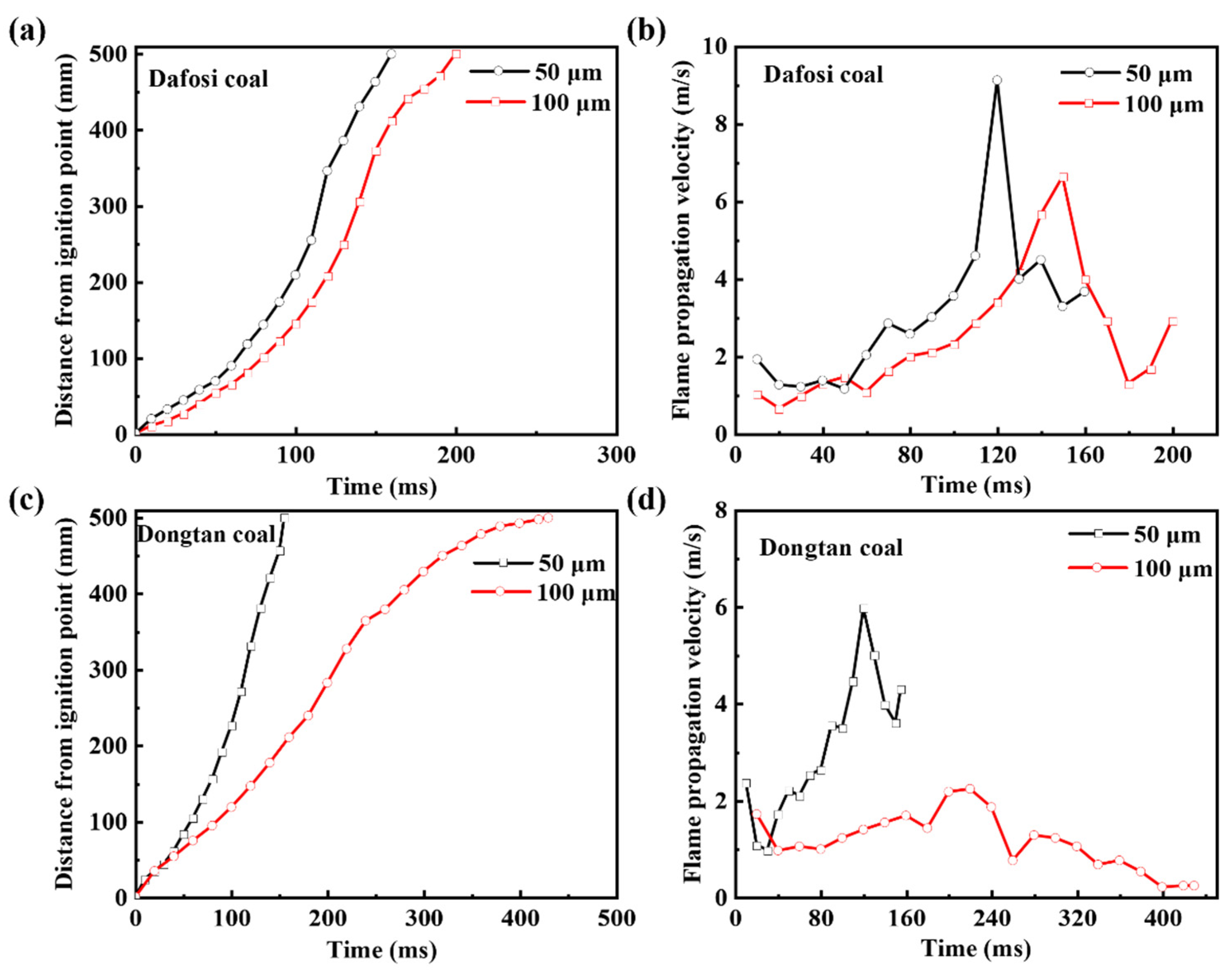
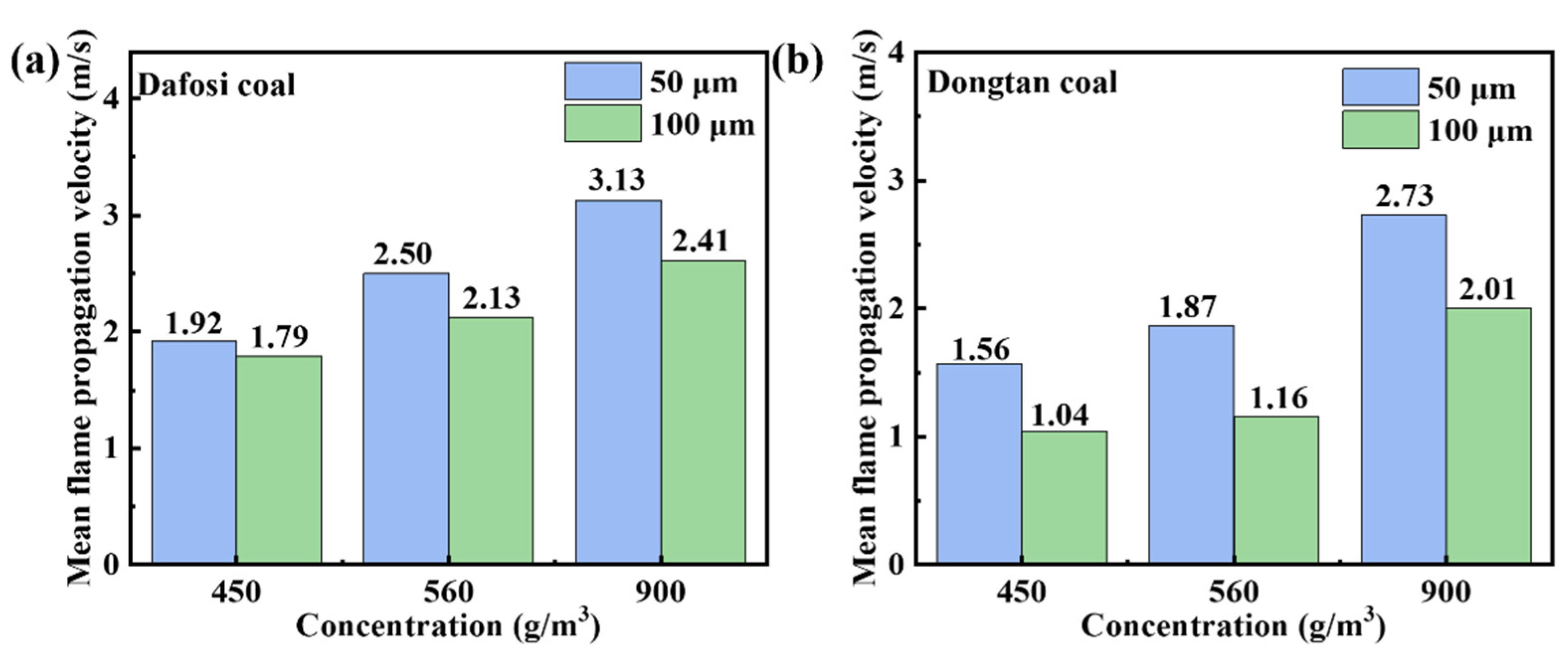
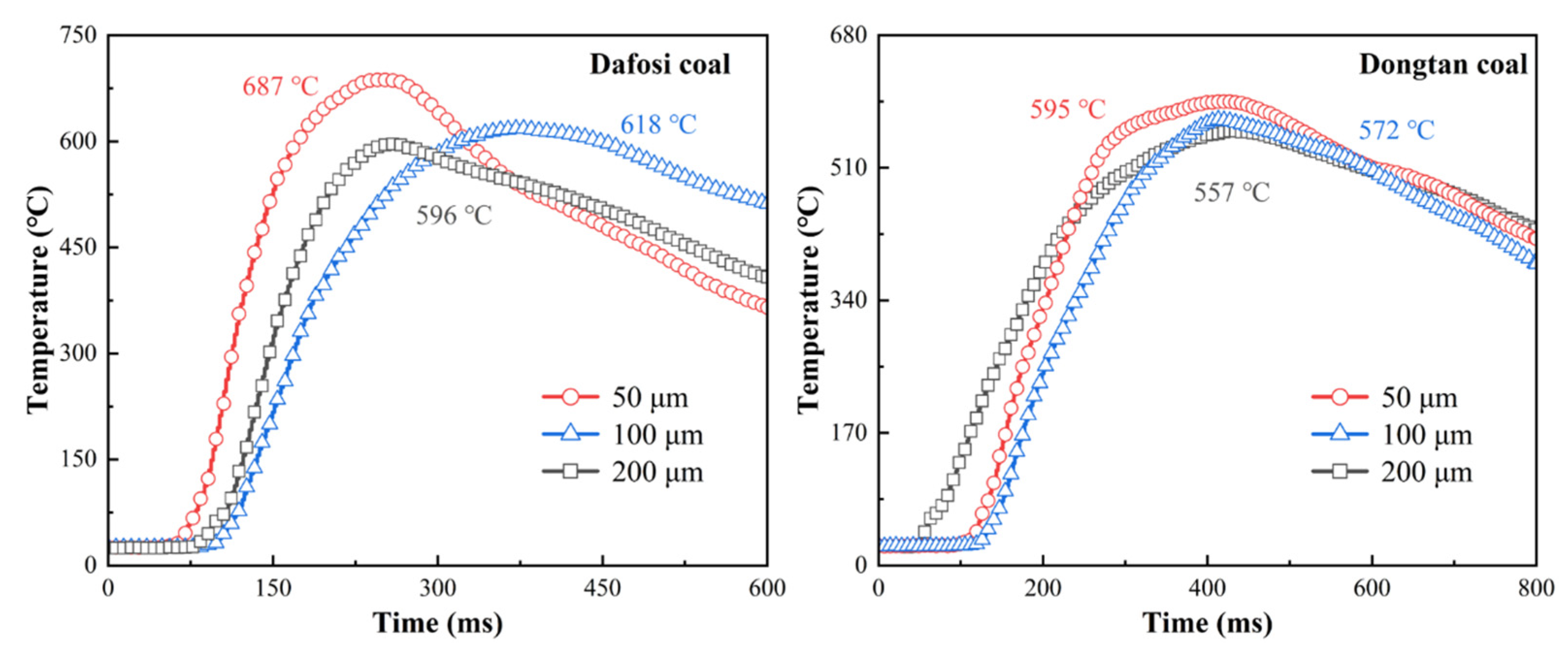


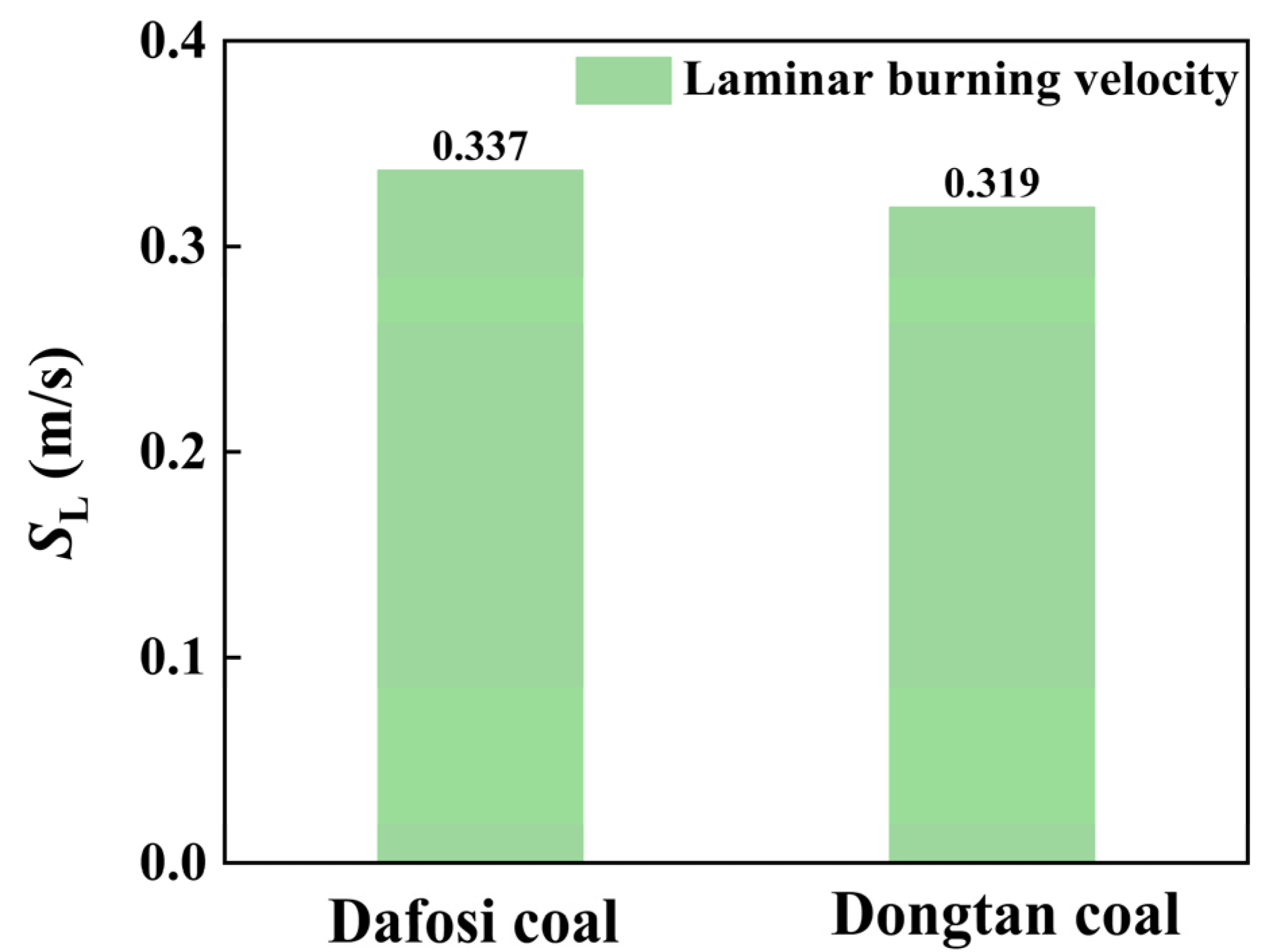
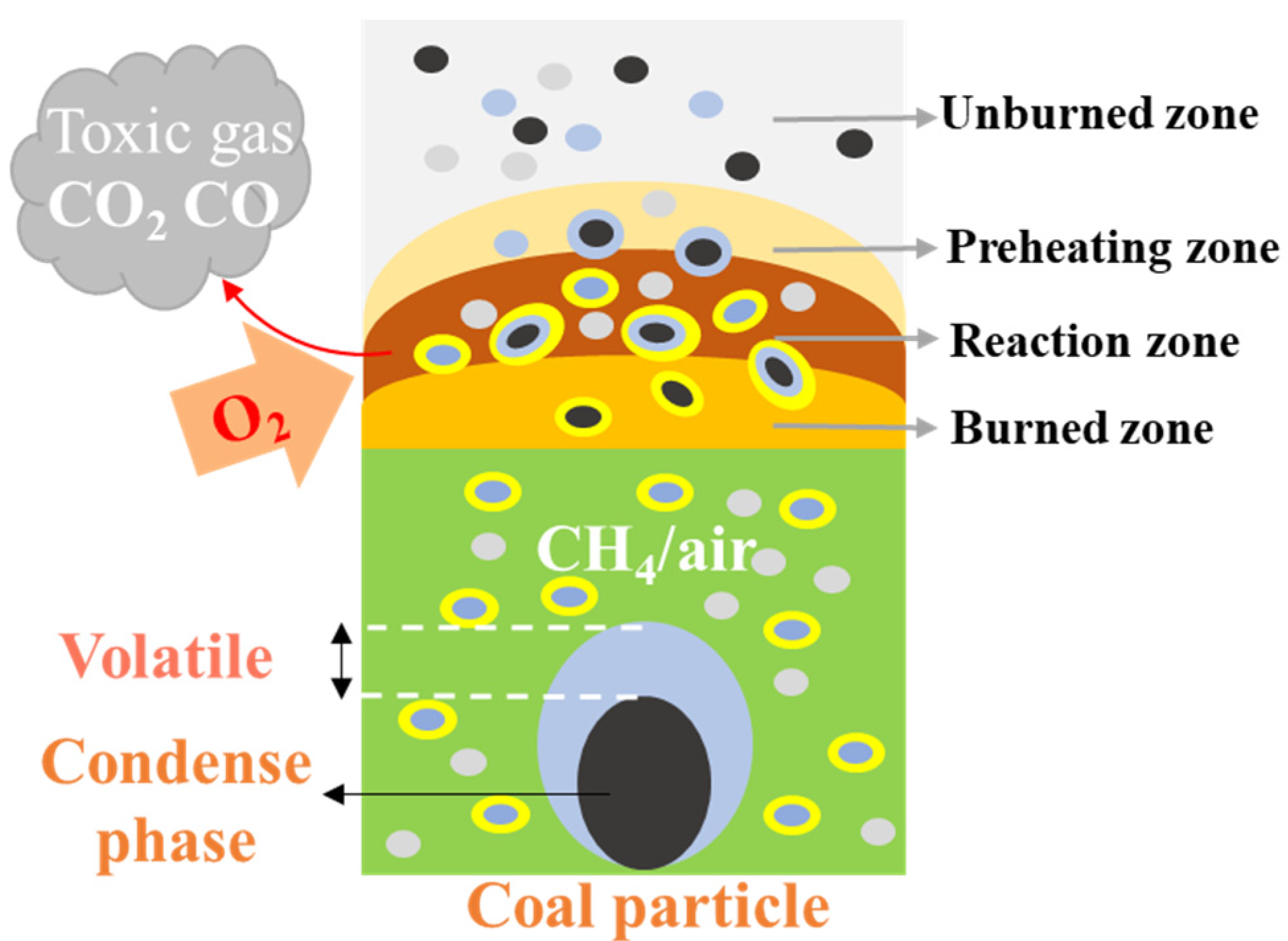
| Component | Ultimate Analysis (wt%) | Proximate Analysis (wt%) | |||||||
|---|---|---|---|---|---|---|---|---|---|
| C | H | N | S | O | Moisture Mad | Ash Aad | Volatile Vad | Fixed Carbon FCad | |
| Dafosi | 75.99 | 3.99 | 0.68 | 0.09 | 19.25 | 3.95 | 5.17 | 28.85 | 62.02 |
| Dongtan | 63.85 | 3.80 | 1.02 | 0.72 | 30.61 | 1.59 | 28.43 | 28.63 | 41.34 |
Disclaimer/Publisher’s Note: The statements, opinions and data contained in all publications are solely those of the individual author(s) and contributor(s) and not of MDPI and/or the editor(s). MDPI and/or the editor(s) disclaim responsibility for any injury to people or property resulting from any ideas, methods, instructions or products referred to in the content. |
© 2024 by the authors. Licensee MDPI, Basel, Switzerland. This article is an open access article distributed under the terms and conditions of the Creative Commons Attribution (CC BY) license (https://creativecommons.org/licenses/by/4.0/).
Share and Cite
Liu, L.; Mao, X.; Jing, Y.; Tang, Y.; Sun, L. Study on the Explosion Mechanism of Low-Concentration Gas and Coal Dust. Fire 2024, 7, 475. https://doi.org/10.3390/fire7120475
Liu L, Mao X, Jing Y, Tang Y, Sun L. Study on the Explosion Mechanism of Low-Concentration Gas and Coal Dust. Fire. 2024; 7(12):475. https://doi.org/10.3390/fire7120475
Chicago/Turabian StyleLiu, Li, Xinyi Mao, Yongheng Jing, Yao Tang, and Le Sun. 2024. "Study on the Explosion Mechanism of Low-Concentration Gas and Coal Dust" Fire 7, no. 12: 475. https://doi.org/10.3390/fire7120475
APA StyleLiu, L., Mao, X., Jing, Y., Tang, Y., & Sun, L. (2024). Study on the Explosion Mechanism of Low-Concentration Gas and Coal Dust. Fire, 7(12), 475. https://doi.org/10.3390/fire7120475





